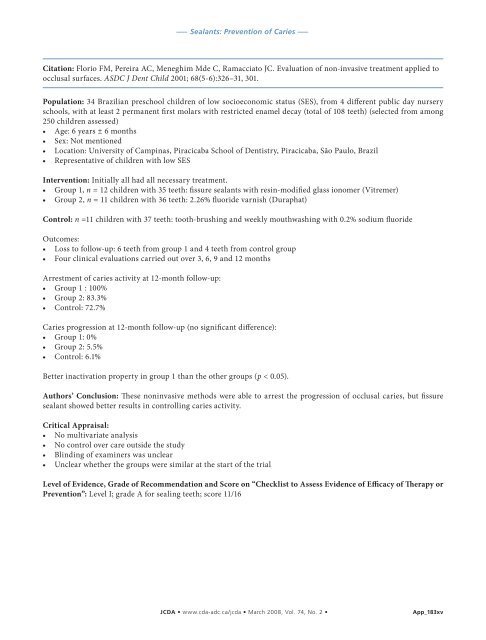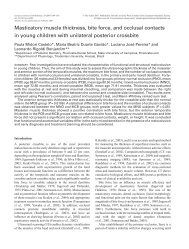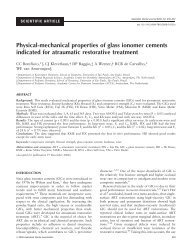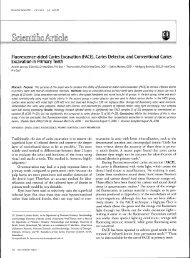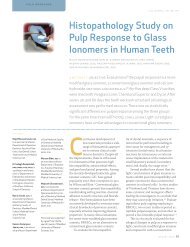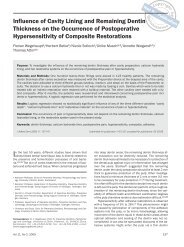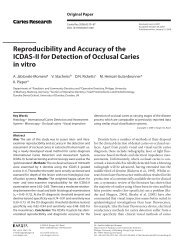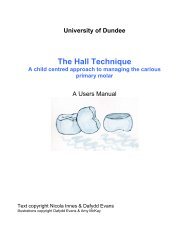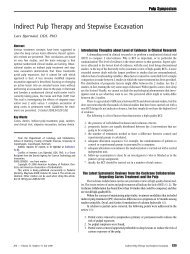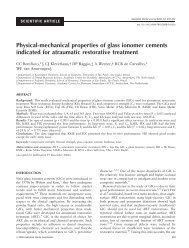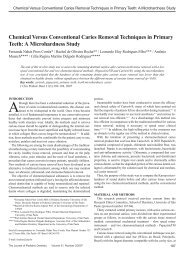Pit and Fissure Sealants in the Prevention of Dental Caries in ...
Pit and Fissure Sealants in the Prevention of Dental Caries in ...
Pit and Fissure Sealants in the Prevention of Dental Caries in ...
Create successful ePaper yourself
Turn your PDF publications into a flip-book with our unique Google optimized e-Paper software.
––– <strong>Sealants</strong>: <strong>Prevention</strong> <strong>of</strong> <strong>Caries</strong> –––<br />
Citation: Florio FM, Pereira AC, Meneghim Mde C, Ramacciato JC. Evaluation <strong>of</strong> non-<strong>in</strong>vasive treatment applied to<br />
occlusal surfaces. ASDC J Dent Child 2001; 68(5-6):326–31, 301.<br />
Population: 34 Brazilian preschool children <strong>of</strong> low socioeconomic status (SES), from 4 different public day nursery<br />
schools, with at least 2 permanent first molars with restricted enamel decay (total <strong>of</strong> 108 teeth) (selected from among<br />
250 children assessed)<br />
• Age: 6 years ± 6 months<br />
• Sex: Not mentioned<br />
• Location: University <strong>of</strong> Camp<strong>in</strong>as, Piracicaba School <strong>of</strong> Dentistry, Piracicaba, São Paulo, Brazil<br />
• Representative <strong>of</strong> children with low SES<br />
Intervention: Initially all had all necessary treatment.<br />
• Group 1, n = 12 children with 35 teeth: fissure sealants with res<strong>in</strong>-modified glass ionomer (Vitremer)<br />
• Group 2, n = 11 children with 36 teeth: 2.26% fluoride varnish (Duraphat)<br />
Control: n =11 children with 37 teeth: tooth-brush<strong>in</strong>g <strong>and</strong> weekly mouthwash<strong>in</strong>g with 0.2% sodium fluoride<br />
Outcomes:<br />
• Loss to follow-up: 6 teeth from group 1 <strong>and</strong> 4 teeth from control group<br />
• Four cl<strong>in</strong>ical evaluations carried out over 3, 6, 9 <strong>and</strong> 12 months<br />
Arrestment <strong>of</strong> caries activity at 12-month follow-up:<br />
• Group 1 : 100%<br />
• Group 2: 83.3%<br />
• Control: 72.7%<br />
<strong>Caries</strong> progression at 12-month follow-up (no significant difference):<br />
• Group 1: 0%<br />
• Group 2: 5.5%<br />
• Control: 6.1%<br />
Better <strong>in</strong>activation property <strong>in</strong> group 1 than <strong>the</strong> o<strong>the</strong>r groups (p < 0.05).<br />
Authors’ Conclusion: These non<strong>in</strong>vasive methods were able to arrest <strong>the</strong> progression <strong>of</strong> occlusal caries, but fissure<br />
sealant showed better results <strong>in</strong> controll<strong>in</strong>g caries activity.<br />
Critical Appraisal:<br />
• No multivariate analysis<br />
• No control over care outside <strong>the</strong> study<br />
• Bl<strong>in</strong>d<strong>in</strong>g <strong>of</strong> exam<strong>in</strong>ers was unclear<br />
• Unclear whe<strong>the</strong>r <strong>the</strong> groups were similar at <strong>the</strong> start <strong>of</strong> <strong>the</strong> trial<br />
Level <strong>of</strong> Evidence, Grade <strong>of</strong> Recommendation <strong>and</strong> Score on “Checklist to Assess Evidence <strong>of</strong> Efficacy <strong>of</strong> Therapy or<br />
<strong>Prevention</strong>”: Level I; grade A for seal<strong>in</strong>g teeth; score 11/16<br />
JCDA • www.cda-adc.ca/jcda • March 2008, Vol. 74, No. 2 • App_183xv


